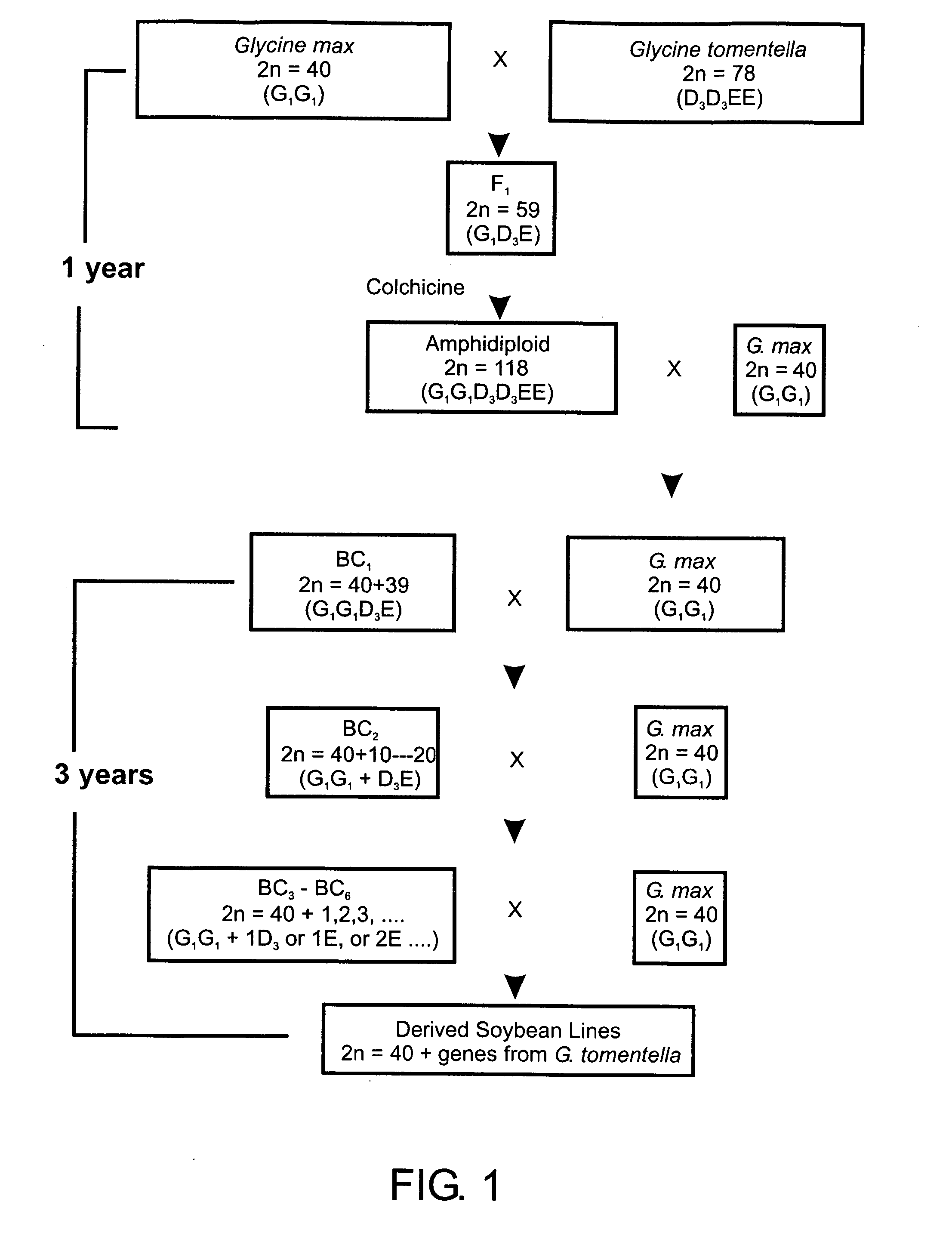Methods for producing fertile crosses between wild and domestic soybean species
- Summary
- Abstract
- Description
- Claims
- Application Information
AI Technical Summary
Benefits of technology
Problems solved by technology
Method used
Image
Examples
example 1
[0094] Wide crosses were made using domestic soybean varieties Dwight (Accession No. PI 597386), Macon (Accession No. PI593258), and Ina (Accession No. PI606749), and wild perennial G. tomentella (Accession Nos. PI441001 and PI441008). The soybean varieties all have 40 chromosomes (2n=40) and G1G1 genomes. G. tomentella PI441001 and PI441008 both have 78 chromosomes (2n=78) and D3D3EE) genomes.
[0095] Both G. tomentella accessions are highly resistant to soybean rust (Schoen, et al. (1992), “Resistance of Glycine tomentella to soybean leaf rust Phakospora pachyrhizi in relation to ploidy level and geographic distribution,” Theor. Appl. Genet. 83:827-832, R. L. Nelson personal communication), and soybean cyst nematode (Riggs et al. (1998), “Possible transfer of resistance to Heterodera Glycines from Glycine tomentella to Glycine max.,” J. Nematol. (Suppl.) 30(4S):547-552).
[0096] When domestic soybean was used as the female parent, soybean flower buds prior to anthesis we...
example 2
Pod Set
[0097] Beginning twenty-four hours after pollination, and every day for 19-21 days, in the mornings, the pollinated soybean gynoecia and subsequent developing pods were sprayed with a growth hormone mixture that had been allowed to come to room temperature. The hormone mixture consisted of gibberellic acid (GA3), naphthaleneacetic acid (NAA) and kinetin (K), using 100 mg GA3, 25 mg NAA and 5 mg K per liter of solution. (Jena, K. K. and Khush, G. S. (1989), “Monosomic alien addition lines of rice: production, morphology, cytology, and breeding behavior,” Genome 32:449-455). Gibberellic acid alone was not effective. A glove was used to protect the skin from the chemicals. After 19-21 days, the pods were physically removed from the plants. One function of the spray is to keep the abscission layer attaching the pod to the plant from drying out and causing the pod to drop off. The hybrid seeds were yellow-green and suspended in dark-green pods, and could easily be distinguished f...
example 3
Surface Sterilization
[0098] After removing the pods from the plants, the pods were surface-sterilized in a solution of 50% commercial Clorox (50 ml commercial Clorox plus 50 ml distilled water) for 15 to 20 minutes in a sterile laminar flow hood. The pods were stirred every five minutes to make sure the entire pod was sterilized, and then removed from the Clorox solution and washed two times in distilled sterile water that has been autoclaved to remove all the Clorox. With a very fine sterilized tweezers and sterilized scalpel, the pod was dissected under a dissecting microscope to remove the yellow-green watery seed.
PUM
 Login to View More
Login to View More Abstract
Description
Claims
Application Information
 Login to View More
Login to View More - R&D
- Intellectual Property
- Life Sciences
- Materials
- Tech Scout
- Unparalleled Data Quality
- Higher Quality Content
- 60% Fewer Hallucinations
Browse by: Latest US Patents, China's latest patents, Technical Efficacy Thesaurus, Application Domain, Technology Topic, Popular Technical Reports.
© 2025 PatSnap. All rights reserved.Legal|Privacy policy|Modern Slavery Act Transparency Statement|Sitemap|About US| Contact US: help@patsnap.com


